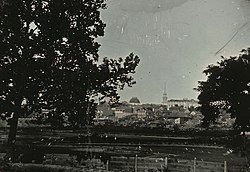Mill Creek Valley (former neighborhood) | |
|---|---|
 Thomas Martin Easterly, St. Louis from across the Mill Creek Valley, 1853, Missouri History Museum | |
| Etymology: Mill Creek, originally known as La Petite Rivière | |
| Coordinates: 38°37′58″N 90°13′19″W / 38.63278°N 90.22194°W | |
| Settled | 1760s |
| Razed | 1959 |
| Area | |
| • Total | 188 ha (465 acres) |
| Population | |
| • Estimate (1959) | 20,000 |
| External maps | Mill Creek Valley maps |
Mill Creek Valley was a historic neighborhood located in the central corridor between 20th Street and Saint Louis University in St. Louis, Missouri.[1] European settlement began in the 18th century with mills established along La Petite Rivière, now known as Mill Creek. It became an industrial and railroad center in the 19th century. Union Station was opened in 1894. The building was closed in 1978 and renovated for commercial use. Also a residential and commercial center, Mill Creek Valley was populated by German immigrants and African Americans, before and after the Civil War. More people moved into the area during World War II to support the war effort.
An urban renewal project of the late 1950s razed most of the residential dwellings, commercial buildings and churches. Although the intention was to establish a prospering commercial and residential area, Saint Louis University and Harris–Stowe State University (HSSU) command much of the former Mill Creek Valley land.
Notable residents include Lucy A. Delaney (c. 1828–1830 – 1910), who wrote about winning her suit for freedom and became a community leader. Also, General William Tecumseh Sherman (1820–1891) who served the Union Army during the American Civil War, and Josephine Baker (1906–1975), an American-born French entertainer, French Resistance agent, and civil rights activist. Another was Erskine Oglesby (1937–2004), an American tenor saxophonist and blues singer.
